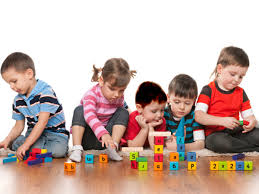http://educationandbehavior.com/
Children learning math concepts benefit from seeing the problems visually and participating in the problem. Visual representation of a math problem makes a huge difference in getting the concept across to the student.
Below are examples of some fun math games and activities you can try with your child or student to help her learn basic facts:
Let’s say you are teaching 3 + 4. Write 3+4 = ? at the top of a piece of paper. Have your child draw three circles on one side of the paper and four circles on the other. Then ask her to color one group the color of her choice, and the other group a color of your choice (pick a different color). After she colors the circles, have her count them and write down the sum where the question mark goes.
For a subtraction game try this: If the equation is 12-3. Have your child count out twelve pieces of a favorite food. Let him eat three pieces, counting backwards each time he eats one, and then counting how many are left. This let’s him visually see the the math problem 12-3 happening right before his eyes and he gets to participate in making it happen. Have him write the equation down 12-3 = 9, when done. As an extra step, have him draw 12 lines above the 12, three lines above the 3, and nine lines above the 9 to reinforce the visual representation.
For a fun multiplication game, try this. Practice 6 X 2 by allowing your child to pick two pieces of celery and put six raisins on each piece. Have her count the raisins at the end and explain how she got her answer. Have her write on paper, 6 X 2 = 12.
For division, put 12 raisins on the table. Have the child divide the raisins into separate groups of six. Ask her how many groups of six she made. This activity gives a visual representation of 12/6 = 2. Because the child is creating the groups herself, it helps her to better understand the concept than if someone else explained it to her. Having kids involved in the process makes more of an impact on their level of understanding.
Number lines are also very helpful in showing kids a visual representation of an addition or subtraction problem. For example, you can have your child start at the number 12, count back three on the number line and end up at 9. Then have him write down, 12 – 3 = 9.
These types of activities give real meaning to what might otherwise be looked at as arbitrary numbers to a child struggling with math.
It is also important to note that computerized learning has become a common method used in the classroom because it allows the students to see pictures accompanied with verbal math problems or explanations. Many teachers use the IPAD to allow students to play math games in which graphics are part of the learning experience. Allow your child to play computerized math games at home for a fun, visual, and participatory experience.
K5 Stars includes over 300 educational computer games. It is a highly rated program by parents and educators. We are not too crazy about the catch phrase “Don’t let your child fall behind”, but the games make learning fun.
For more suggestions to help a child with math, visit the E-Learning center and Wise Market of Wise Education and Behavior.
Any questions? Contact us.
Stop by our forum to discuss concerns or give advice regarding childhood learning and behavior.
For more tips on learning and behavior visit the Learning/Behavior Tips section of Wise Education and Behavior We share a new tip on learning or behavior every day. Check out our articles on behavior, reading, math, writing, and general learning.
Thank you for reading.


Pingback: Teaching Mental Math: Basic Addition | Wise Education and Behavior
Pingback: Math Strategies for Elementary School Students | Wise Education and Behavior